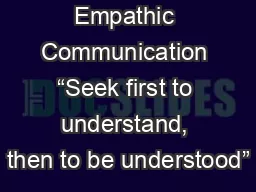

October 4 2013 Rena Herbert Presentation Objectives Identify the four basic types of communication Examine the importance of character as an influence Explain the statement diagnosing before one prescribes ID: 685390
Download Presentation The PPT/PDF document "Empathic Communication “Seek first to ..." is the property of its rightful owner. Permission is granted to download and print the materials on this web site for personal, non-commercial use only, and to display it on your personal computer provided you do not modify the materials and that you retain all copyright notices contained in the materials. By downloading content from our website, you accept the terms of this agreement.
Slide1
Empathic Communication
“Seek first to understand, then to be understood”October 4, 2013Rena’ HerbertSlide2
Presentation Objectives:
Identify the four basic types of communication.Examine the importance of “character” as an influence.Explain the statement diagnosing before one prescribes.
Describe the four autobiographical responses.Explore the levels of “listening”.Discuss empathic listening and its four developmental stages.
Finally we must seek to be understood. Slide3
Four Basic Types of Communication
Reading
Writing
Speaking
Listening
1Slide4
“Character “ as an influence
-The key to your influence of others is your example, your behavior, and your overall conduct.
2Slide5
Diagnosing Before You Prescribe
According to the 7 Habits of Highly Effective People, "The key to good judgment is understanding. By judging first, a person will never fully understand” Covey p.245.
3Slide6
The Four Autobiographical Responses
To evaluateTo probe To advise
To interpret
4Slide7
Levels of Listening
Ignoring or not listening Pretending to listen
Selective listening Attentive listening
Empathic listening
5Slide8
Four Developmental Stages of Empathic Listening
1st Stage is Mimic content, a skill often taught in “active” or “reflective” listening.2nd Stage is to rephrase the content.
3rd Stage is to reflect feeling.
4
th
Stage is to rephrase the content and reflect the feeling.
6Slide9
Seek To Be Understood
Seeking to understand requires consideration…Seeking to be understood takes courage…
7Slide10
Bibliography
Convey, S. (1989). The 7 Habits of Highly Effective People. New York, NY: Convey Slide11
Thank you for your time…
We must become the change we wish to see in the world.
- Mohandas (Mahatma) Gandhi